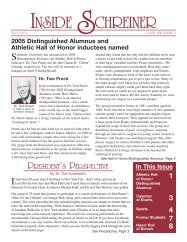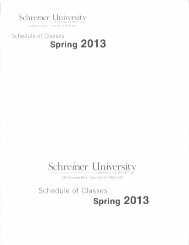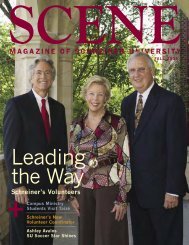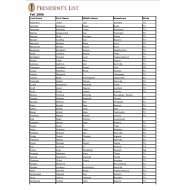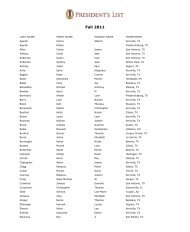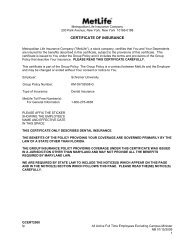Schreiner University Drug-Free Schools and Campuses Prevention ...
Schreiner University Drug-Free Schools and Campuses Prevention ...
Schreiner University Drug-Free Schools and Campuses Prevention ...
Create successful ePaper yourself
Turn your PDF publications into a flip-book with our unique Google optimized e-Paper software.
<strong>Schreiner</strong> <strong>University</strong> <strong>Drug</strong>-<strong>Free</strong> <strong>Schools</strong> <strong>and</strong> <strong>Campuses</strong> <strong>Prevention</strong><br />
Program<br />
(Revised August, 2012)<br />
General Statements on Contents of the Biennial Reivew:<br />
The Biennial review should be completed by July 30 of even numbered years, <strong>and</strong> the<br />
report should cover that calendar year <strong>and</strong> the previous odd-numbered year as well.<br />
(Note: while federal law requires a report every two years, <strong>Schreiner</strong> <strong>University</strong> finds it<br />
more convenient to prepare the report annually.)<br />
There are two objectives to the review: 1. to determine effectiveness of <strong>and</strong> to<br />
implement any needed changes to the Alcohol <strong>and</strong> Other <strong>Drug</strong> (AOD) prevention<br />
program 2. To ensure that campuses enforce the disciplinary sanctions for violating<br />
st<strong>and</strong>ards of conduct consistently.<br />
The Biennial review should have a clear description of AOD related problems, strategic<br />
interventions, <strong>and</strong> desired outcomes. A sound evaluation plan is critical to determining<br />
the evidence basis or programs.<br />
The Biennial review should list all of the activities that compose their prevention<br />
program <strong>and</strong> identify the effectiveness of these efforts at meeting prevention goals <strong>and</strong><br />
outcomes.<br />
The Biennial review is best achieved through a task force of a diverse representation of<br />
campus employees, including Residential life, campus security, health, judicial,<br />
athletics, <strong>and</strong> other staff. When necessary a smaller sub-committee can prepare the<br />
report.<br />
The Biennial review should conduct a policy inventory <strong>and</strong> then judge the policies for<br />
effectiveness <strong>and</strong> consistent enforcement. For example, all types of students should be<br />
held to the same policy st<strong>and</strong>ards <strong>and</strong> sanctioned similarly. The review should assess<br />
whether goals <strong>and</strong> outcomes are moving the <strong>University</strong> in the desired direction.<br />
The Biennial review should include materials to complement the report, include<br />
information on program effectiveness, detail the goals <strong>and</strong> achievements, include<br />
recommendations for revision.<br />
The Biennial review should describe the program elements <strong>and</strong> activities implemented<br />
to achieve goals <strong>and</strong> outcomes. Elements may refer to the five strategical<br />
environmental intervention areas: alcohol-free options, alcohol-free college experience<br />
as norm, unavailability of alcohol, prohibition of marketing of alcohol, <strong>and</strong> development
of policies that consistently enforce laws. The Biennial review should also include the<br />
supplemental checklist provided by the Department of Education.<br />
The Biennial review should give a statement of AOD program goals <strong>and</strong> a discussion of<br />
goal achievement. Outcomes are measurable statements of the increases in positive<br />
behaviors <strong>and</strong> degreases in negative behaviors that are expected when program goals<br />
are met.<br />
The Biennial Review should provide a summary of AOD program strengths <strong>and</strong><br />
weaknesses. These may include infrastructure supports such as administrative<br />
leadership, adequate budget, campus <strong>and</strong> community coalition, etc. Program<br />
weaknesses are areas that have created challenges for prevention efforts or barriers to<br />
progress such as lack of data or leadership.<br />
The Biennial Review should describe the ways the university has distributed its annual<br />
notification to students <strong>and</strong> employees.<br />
The Biennial Review should include copies of the policies which were distributed.<br />
Efforts should be made to review <strong>and</strong> revise the policies on a regular basis to reflect<br />
case law <strong>and</strong> changes in federal, state, <strong>and</strong> local laws, <strong>and</strong> to ensure that the policies<br />
are reasonable, comprehensive, <strong>and</strong> enforceable.<br />
The Biennial Review should include recommendations for revising the AOD programs.<br />
The Biennial review should measure enforcement consistency. Charts document each<br />
case, excluding identifying information, to present offenses, mitigating circumstances,<br />
<strong>and</strong> disposition. Similar cases are grouped together to facilitate comparisons.<br />
The Biennial Review should measure policy <strong>and</strong> program effectiveness. in the following<br />
ways: it should assess whether the program is based on needs assessment of objective<br />
data, there should be a measurable set of goals <strong>and</strong> objectives linked to the needs, <strong>and</strong><br />
there should be prevention activities linked to evidence based programs, <strong>and</strong> evaluation<br />
should be used to refine, improve, <strong>and</strong> strengthen the program.<br />
The Biennial Review may use the following measures: disciplinary sanctions imposed,<br />
referrals for counseling or treatment, incidents recorded in campus security or police<br />
logs, incidents of v<strong>and</strong>alism. Other potential measures include the following: the<br />
number of students, faculty, staff attending alcohol programs; student or employee<br />
perceptions about AOD problems on campus; or use levels of AOD by students <strong>and</strong><br />
employees as indicated by surveys.





